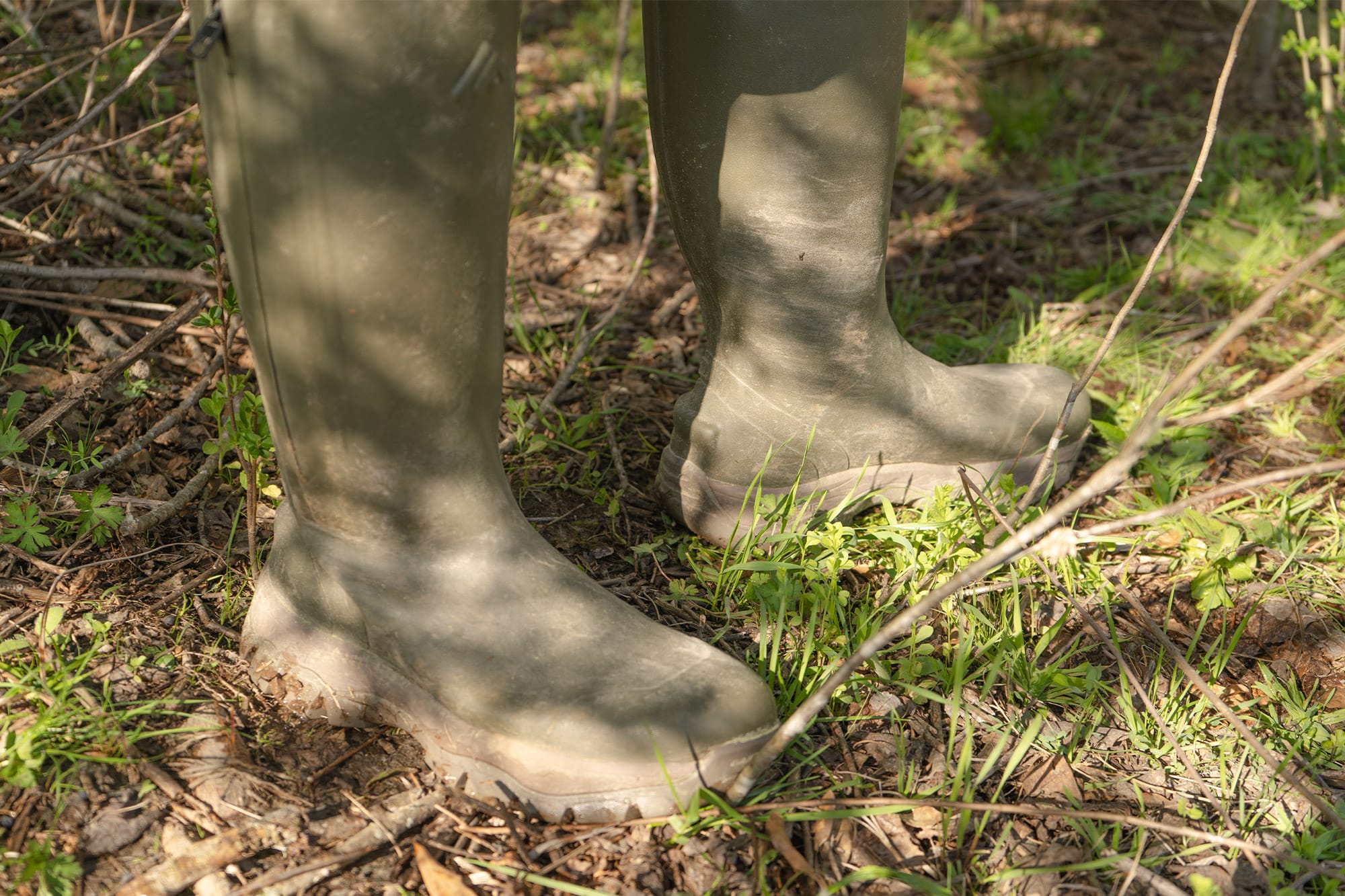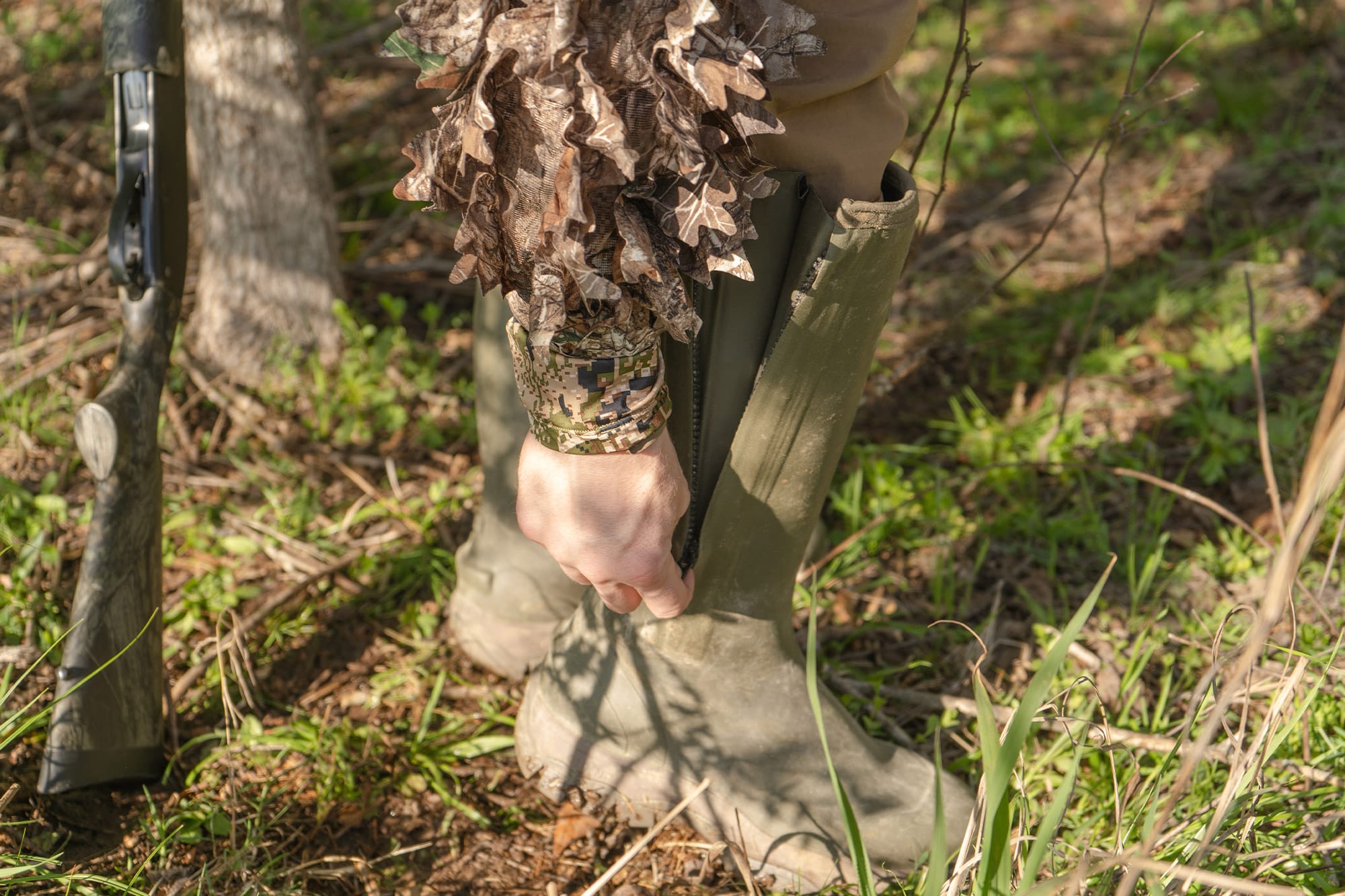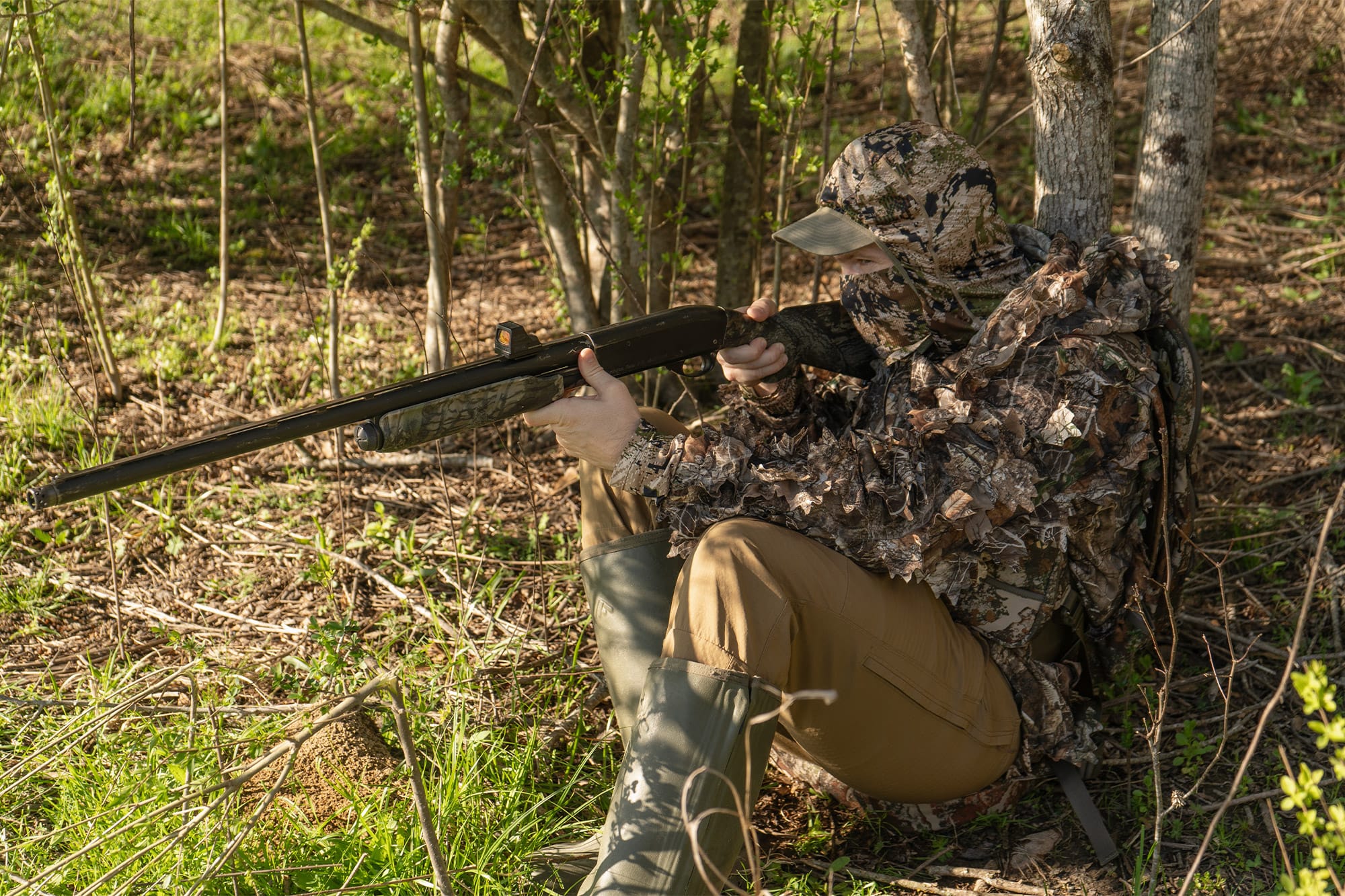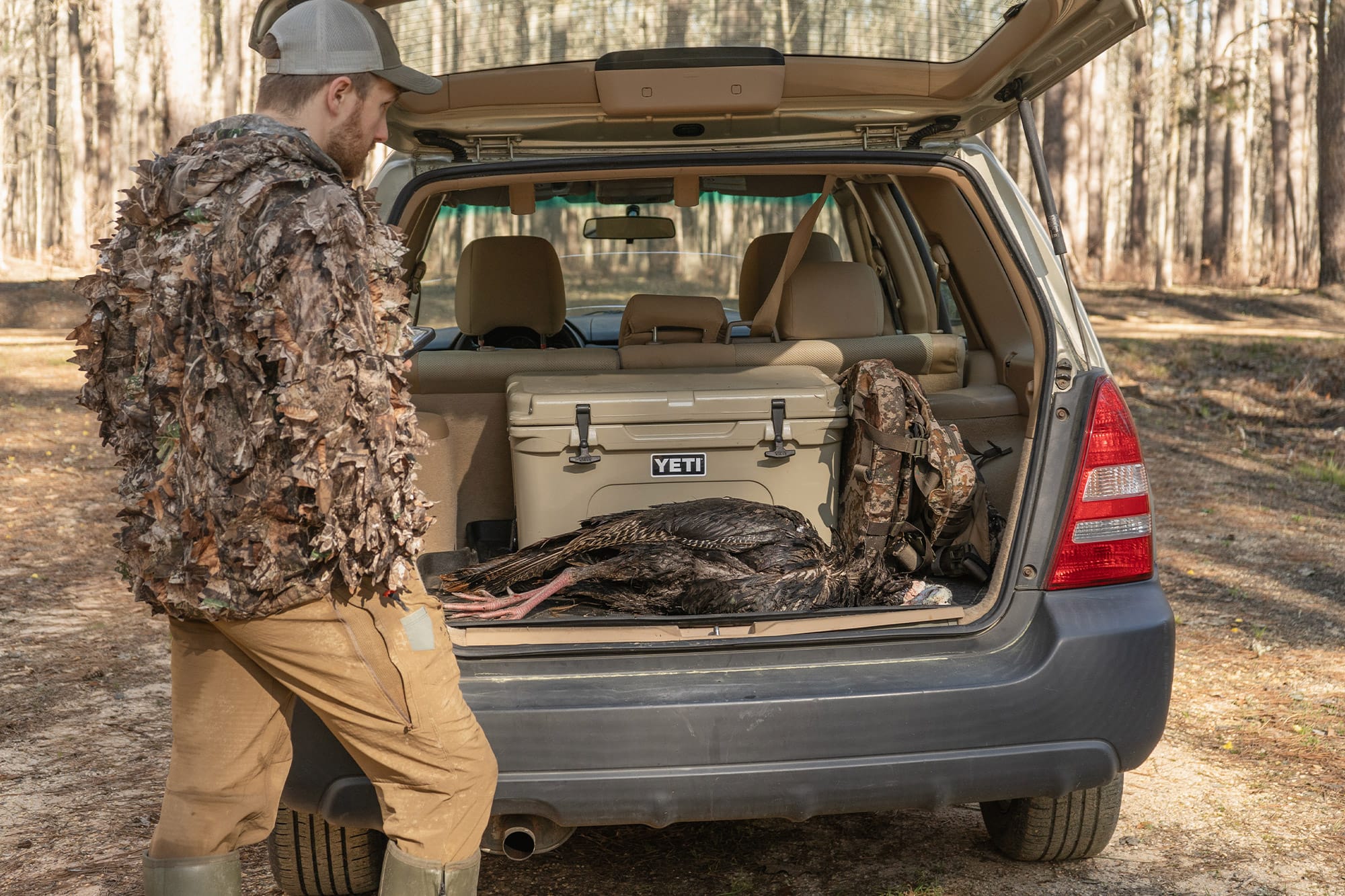Rubber hunting boots usually aren’t praised for being light on your feet. They’re often heavy, sweaty, and not exactly the kind of boots you want to walk long miles in. Most hunters know the feeling—your legs are fine, but your boots feel like cinder blocks.
That said, the Chêne Floodline Velo boot changes the game. The lower section fits snug and secure, giving you solid footing, while the uninsulated air-mesh lining lets your feet breathe. No more cooking your toes during warm-weather hunts.
They’re versatile too—you can wear them for spring turkey and keep them going well into early whitetail season. And when the day’s done, the waterproof zippered gusset makes them easy to kick off, even after hours of run-and-gun hunting.
Bottom line: If you’re a hunter who wants full rubber boot protection without sacrificing comfort, the Chêne Floodline Velo is worth a hard look.
Chêne Floodline Velo Boot

- Height:
Not listed, approximately 15″ - Weight:
4.5 lbs. (per pair) - Insulation:
None - Upper Material:
Rubber with air mesh lining
Pros
- Snug fit
- Super easy on/off
- No break-in period
- Breathable for a rubber boot
- Great for run-and-gun
Cons
- Traction could be better
- No women’s sizes
Chêne Floodline Velo Boot Review
Testing the Chêne Floodline Velo Boots

I’ve had the chance to put the Chêne Floodline Velo boots through their paces during some post-season whitetail scouting and the early days of turkey season. My testing grounds were the wet, snake-filled river bottoms of the deep South—about as tough a proving ground as you can find. The Velos handled it all with confidence.
Right away, what stood out was how light and flexible these boots feel. Instead of that stiff, clunky rubber-boot vibe, they fit more like a solid pair of shoes. That makes a big difference when you’re covering miles.
On the very first trip, I knocked out about six miles of scouting and didn’t get so much as a hot spot. Normally, rubber boots take some breaking in, but these felt broken in from day one—comfortable and supportive like a pair I’d been wearing for seasons.
Opening week of turkey season gave me another chance to test them. I hunted a spot a few miles from the road, tagged a bird, and hiked back out without a single blister. The roomy toe box kept my feet comfortable, and even after putting in the miles, I never once thought, “Man, I can’t wait to get these off.”
I hunt a lot of ground that stays wet year-round, so keeping my feet dry is non-negotiable. The Velos have done that without fail. Even on long, hard days, I don’t think twice about lacing them up. They’ve quickly become my go-to rubber boots.
One of the best parts? Taking them off. Anyone who’s wrestled with tight rubber boots knows it can be a battle. With the Velos, I can slip them off hands-free—even after a long day—without messing with the zipper. That little detail makes a big difference.
Bottom line: I hardly notice these boots when I’m wearing them, and that’s exactly how good gear should be.
What the Chêne Floodline Velo Boots Do Best

Rubber hunting boots usually aren’t known for being breathable—and when your feet start sweating, getting them off can be a real chore. That’s not the case with the Chêne Floodline Velo boots. I spend a lot of time hunting the river bottoms of the Deep South, where snakes and standing water rule out lightweight hikers. In those conditions, the Velos make run-and-gun hunting feel easy.
Even after a few miles, my feet stay comfortable instead of sloshing in sweat. They don’t weigh me down, and when I finally make it back to the truck, slipping them off takes no effort at all.
What I like most is that the Velos don’t even feel like traditional rubber boots. The flexible uppers keep me light on my feet, letting me move quickly and quietly. That’s not something I can say about most other rubber boots I’ve tried.
Where the Floodline Boots Can Improve

The Floodline Velo boots really shine for early-season hunts and chasing spring gobblers. They’re lightweight, comfortable right out of the box, and breathable enough to keep your feet cool on long hikes through the woods. The snug fit and solid ankle support make it easier to move quietly and handle uneven ground—something every turkey hunter can appreciate when trying to close the distance on a wary bird.
That said, the traction could be better. The soles have a shallow tread without aggressive lugs, which can make footing sketchy in slick conditions.
Crossing creeks or dealing with muddy banks during wet spring days is where it shows the most. Mossy rocks and sloppy mud call for a firmer bite than these soles deliver. With a more rugged outsole, these boots could easily rank as a top pick for serious spring hunters.
Final Thoughts

I was sold on the Floodline Velo boots the moment I slipped them on. They’ve got the comfort, snug fit, and breathability that run-and-gun hunters are always looking for in a multiseason boot. If you hunt the Deep South—or just prefer the protection of rubber boots—it’s hard to find a better option.
These boots give you the waterproof reliability of a rubber boot while still feeling as light and comfortable as a good pair of hikers. For anyone who doesn’t want to choose between comfort and performance, the Chêne Floodline Velo is well worth a look.
FAQ’s
Can you use Hunter boots for hiking?
You *can*, but they’re not the best choice. Hunter boots are designed more for wet, muddy conditions than rocky trails. If you’re only doing a short walk or dealing with puddles and slush, they’ll do fine. For longer hikes, though, proper hiking boots with ankle support and better traction are a lot more comfortable.
Are hunting boots the same as hiking boots?
Not exactly. Hunting boots are built to keep your feet warm, dry, and quiet while you move through brush or sit in a stand. Hiking boots are focused on support, comfort, and breathability for steady walking. They overlap a little, but they’re made with different priorities in mind.
Are muck boots ok for walking in?
Yes, muck boots are good for walking around fields, farms, or wet ground. They’re waterproof and easy to clean. That said, they’re not meant for long-distance hiking. After a few miles, you might notice the weight and lack of support.
What are the best rubber boots for hunting?
Chêne, Lacrosse, and Bogs are popular choices among hunters. They’re waterproof, durable, and some models are insulated for cold weather. The “best” really depends on your hunting conditions—warm swampy ground calls for something lightweight, while a late-season deer hunt might require heavy insulation.
Can you walk long distances in Hunter boots?
Not comfortably. They’re fine for short treks, but if you’re covering miles, your feet will feel it. Rubber boots just don’t breathe like leather or fabric hiking boots.
Why is Hunter so expensive?
You’re paying for the brand as much as the boot. Hunter has been around since the 1800s, and they market themselves as a stylish, heritage company. The materials are decent, but the high price is largely tied to fashion appeal.
Can you hike in wellies?
Only if you’re keeping it short and easy. Wellies (rubber boots) protect you from mud and water, but they don’t give the ankle support or cushioning you need for real hiking.
Are Hunter boots comfy to walk in?
For short city walks, yes. For all-day wear or hiking, not so much. The lack of padding and support shows pretty quickly.
How to tell fake Hunter wellies?
Check the logo—real Hunters have a neat, centered label on the front with sharp lettering. Fakes often have uneven stitching, cheap-looking rubber, or packaging that feels off. Buying from official retailers is the safest way.
What kind of hiking boots do Bear Grylls wear?
Bear Grylls has been spotted wearing Merrell and Salomon boots over the years. He usually goes for lightweight, tough boots built for rough terrain.
Are hunting boots worth it?
If you hunt regularly, absolutely. A good pair keeps you dry, warm, and comfortable in the woods, which can make or break a hunt. If you don’t hunt much, a solid hiking boot may serve you better.
How to tell if a boot is a hiking boot?
Hiking boots usually have thick soles with grippy tread, firm ankle support, and are made from breathable but durable materials like leather or synthetics. They’ll feel stiffer and more supportive than casual boots.
Do you want hunting boots tight or loose?
Neither. You want them snug enough so your heel doesn’t slip, but with enough room for thick socks. Too tight and you’ll lose circulation; too loose and you’ll get blisters.
Which Hunter boots are best for walking?
The “Original Tall” is the most common, but the “Hunter Refined” line is a bit lighter and slimmer, making it easier for walking. Still, they’re not hiking boots by any stretch.
Are you supposed to wear socks with Hunter boots?
Yes—always. Thick socks help with comfort, warmth, and reducing blisters. Some people even use Hunter’s own boot socks, which fold over the top.
Are Hunter boots made in China?
Yes. While the brand started in Scotland, most Hunter boots today are manufactured in China.
Can you wear Hunter boots every day?
You can, especially in wet weather, but they’re not ideal for daily use if you’re walking long distances. For fashion or rainy commutes, they’re fine.
Are wellies or walking boots better?
It depends on the conditions. Wellies win in mud, rain, and puddles. Walking boots win on long, dry, or rocky trails.
Can you hike in Hunter boots?
Technically yes, but you won’t enjoy it after a while. They’re heavy, sweaty, and lack support. Stick with hiking boots if you’re planning a real trek.
Why do Hunter boots crack?
Rubber naturally dries out and cracks over time, especially if you don’t store them properly. Sunlight and heat make it worse. Using a rubber conditioner helps extend their life.
Are Hunter boots out of style in 2025?
They’re not as trendy as they were a decade ago, but they’re still around. These days, they’re more of a practical rainy-day boot than a fashion statement.
